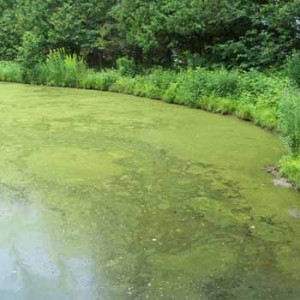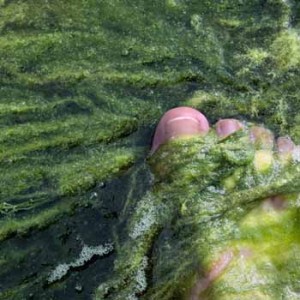Blue-Green Algae, or Cyanobacteria
Our lovely corner of the world has been hard hit by numerous blue-green algae blooms over these past few summers. Understandably citizens are concerned about safety, their property investments along the lakeshore and how this affects their recreational activities and lifestyles. We turn to the government to seek information, advice and action which often leaves us feeling frustrated. What we need to do is to take a good hard look at our own practices and evaluate how they might possibly contribute to the problem of blue green algae blooms. Think globally act locally.
 Globally we are all experiencing the effects of global warming. What the scientists have been warning us about for decades is now happening; we are living in a changing climate that is becoming increasingly harsh and unpredictable. What can I do, you ask? Drive your car less, walk and cycle more. Plan your car trips for shopping with other outings so you use the car less. Share driving. Institute carpooling where you work. Sell one vehicle. Don`t wait for the government to save our planet, you start and maybe the institutions will follow. How does this relate to your pond or lake? The blue green algae bloom like warm water temperatures, so until we change our output of greenhouse gases on a global scale, one car or action at a time, your pond will likely experience more frequent and persistent algae bloom problems in the future.
Globally we are all experiencing the effects of global warming. What the scientists have been warning us about for decades is now happening; we are living in a changing climate that is becoming increasingly harsh and unpredictable. What can I do, you ask? Drive your car less, walk and cycle more. Plan your car trips for shopping with other outings so you use the car less. Share driving. Institute carpooling where you work. Sell one vehicle. Don`t wait for the government to save our planet, you start and maybe the institutions will follow. How does this relate to your pond or lake? The blue green algae bloom like warm water temperatures, so until we change our output of greenhouse gases on a global scale, one car or action at a time, your pond will likely experience more frequent and persistent algae bloom problems in the future.
For the pond owner or resident living along affected lakes, do a small watershed checklist and action plan, to see how your own actions are contributing to poor water quality in your pond or lake.
Do you mow your lawn up to the shoreline? If so, this is detrimental for water quality because short grass cannot absorb excessive nutrients such as phosphorous, like a lush band of shoreline plants and aquatic plants can. Blue-green algae bloom with too much phosphorous. Plant indigenous shrubs along your shoreline and avoid lawn mowing as much as possible. Certainly, never fertilize your lawn; you are just contributing to poor water quality for everyone. Paved land, driveways and roads allow surface water to enter your lake easily, carrying with it  pollutants and nutrients that feed algae. If possible, remove these surfaces, or plant berms around them so that the plant roots can take up excess moisture, and the soil can absorb the water. For streams that cross your land and enter the lake, do the same thing, plant indigenous aquatic plants in and along the stream and never mow up to the stream edge. Become the annoying neighbour who makes friendly suggestions to the lawn mowing landowner down lake from you. If you have the means to do so, offer to buy plants and plant them for the farmer down the road who is struggling to make ends meet. Screaming at town council meetings will accomplish less than taking action yourself and spreading the word through your own positive ways. Instead of the man who planted trees become the woman who planted aquatics! Again, think globally, act locally. If your goal is to keep your lakeside property enjoyable and your lake safe for recreation, start now, mobilize your neighbours and lake community; take it upon yourselves to make the necessary changes, so at least you can say you tried your best. The new buzz word for water quality is not a new concept at all, but an increasingly important one: watershed management. It begins where the mountains and fields flow into your lake and ends eventually at sea level. So managing local watersheds properly is the key to great water quality.
pollutants and nutrients that feed algae. If possible, remove these surfaces, or plant berms around them so that the plant roots can take up excess moisture, and the soil can absorb the water. For streams that cross your land and enter the lake, do the same thing, plant indigenous aquatic plants in and along the stream and never mow up to the stream edge. Become the annoying neighbour who makes friendly suggestions to the lawn mowing landowner down lake from you. If you have the means to do so, offer to buy plants and plant them for the farmer down the road who is struggling to make ends meet. Screaming at town council meetings will accomplish less than taking action yourself and spreading the word through your own positive ways. Instead of the man who planted trees become the woman who planted aquatics! Again, think globally, act locally. If your goal is to keep your lakeside property enjoyable and your lake safe for recreation, start now, mobilize your neighbours and lake community; take it upon yourselves to make the necessary changes, so at least you can say you tried your best. The new buzz word for water quality is not a new concept at all, but an increasingly important one: watershed management. It begins where the mountains and fields flow into your lake and ends eventually at sea level. So managing local watersheds properly is the key to great water quality.
Our approach to aquatic management is two-fold: always take great care to manage the watershed properly as a preventative measure and when the situation is so bad that the health of wildlife is at risk or the enjoyment of your lake is impeded, take immediate action that involves the benefits of biology + technology, like adding much needed oxygen through aeration. We are also finding the latest technologies that mimic nature are very effective in problem situations; such is the case with using beneficial bacteria and floating islands. This approach of global action, protecting the watershed and using the latest benefits of biology + technology is showing exciting results among our clients.
Read also:
- Eutrophisation et algues bleues | Xavier-Antoine Lalande, Québec Vert magasine, 2010 (in French, PDF)
- Visible cyanobacteria blooms? Important precautions for you and your family